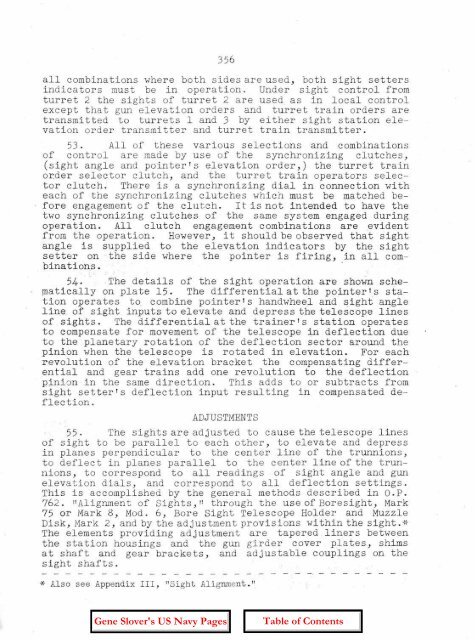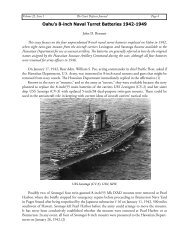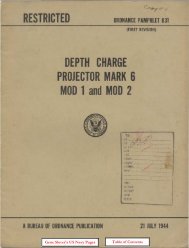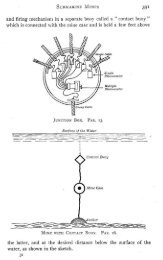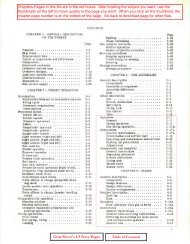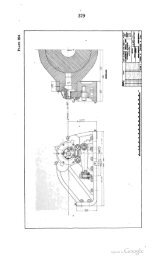OP-755 Part 2 Pages 197-401 - Personal Page of GENE SLOVER
OP-755 Part 2 Pages 197-401 - Personal Page of GENE SLOVER
OP-755 Part 2 Pages 197-401 - Personal Page of GENE SLOVER
Create successful ePaper yourself
Turn your PDF publications into a flip-book with our unique Google optimized e-Paper software.
356<br />
all combinations where both sides are used, both sight setters<br />
indicators must be in operation. Under sight control from<br />
turret 2 the sights <strong>of</strong> turret 2 are used as in local control<br />
except that gun elevation orders and turret train orders are<br />
transmitted to turrets 1 and 3 by either sight station elevation<br />
order transmitter and turret train transmitter.<br />
53. All <strong>of</strong> these various selections and combinations<br />
<strong>of</strong> control are made by use <strong>of</strong> the synchronizing clutches,<br />
(sight angle and pointer's elevation order,) the turret train<br />
order selector clutch, and the turret train operators selector<br />
clutch. There is a synchronizing dial in connection with<br />
each <strong>of</strong> the synchronizing clutches which must be matched before<br />
engagement <strong>of</strong> the clutch. It is not intended to have the<br />
two synchronizing clutches <strong>of</strong> the same system engaged during<br />
operation. All clutch engagement combinations are evident<br />
from the operation. However , it should be observed that sight<br />
angle is supplied to the elevation indicators by the sight<br />
setter on' the side where the pointer is firilig, in all combinatiohs.<br />
54. The details <strong>of</strong> the sight operation ar~ sho~n schematLca.Lly<br />
on plate 15. The differential at the pointer's station<br />
operates to combine pointer IS handwheel arid sLght angle<br />
Lf.ne <strong>of</strong> sight inputs to elevate and depress the telescope lines<br />
<strong>of</strong> sights. The differential at the trainer's station operates<br />
to compensate for movement <strong>of</strong> the telescope in deflection due<br />
to the planetary rotation <strong>of</strong> the deflection sector around the<br />
pinion when the telescope is rotated in elevation. For each<br />
revolution <strong>of</strong> the elevation bracket the compensating differential<br />
and gear trains add one revolution to the deflection<br />
pinion in the same direction. This adds to or subtracts from<br />
sight setter's deflection input resulting in compensated deflection.<br />
ADJUSTMENTS<br />
55. The sights are adjusted to cause the telescope lines<br />
<strong>of</strong> sight to be parallel to each other, to elevate and depress<br />
in planes perpendicular to the center line <strong>of</strong> the trunnions,<br />
to deflect in planes parallel to the center line <strong>of</strong> the trunnions,<br />
to correspond to all readings <strong>of</strong> sight angle and gun<br />
elevation dials, and correspond to all deflection settings.<br />
This is accomplished by the general methods described in a.p.<br />
762. "Alignment <strong>of</strong> Sights," through the use <strong>of</strong> Boresight, Mark<br />
75 or Mark 8, Mod. 6, Bore Sight Telescope Holder and Muzzle<br />
Disk, Mark 2, and by the adjus tment provisions within the sLgrrt .«<br />
The elements providing adjustment are tapered liners between<br />
the station housings and the gun girder cover plates, shims<br />
at shaft and gear brackets, and adjustable couplings on the<br />
sight shafts.<br />
* Also see Appendix III, tlSight Alignment. tl


